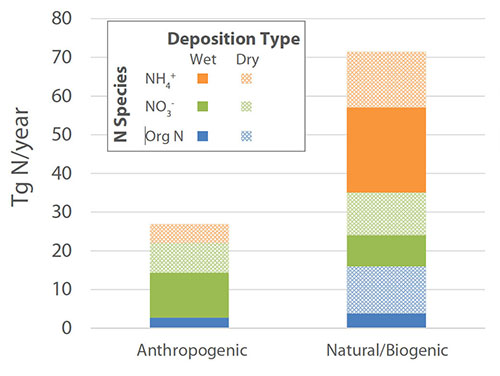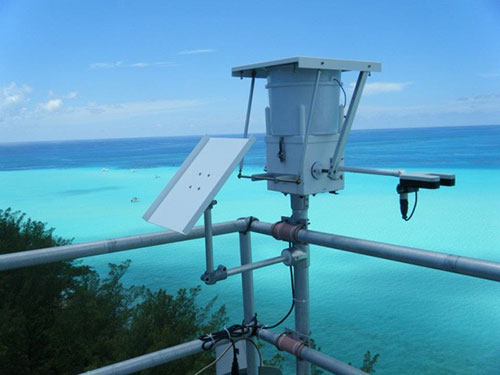PROVIDENCE, R.I. [Brown University] — A new study finds that human activities are likely contributing far less nitrogen to the open ocean than many atmospheric models suggest. That’s generally good news, but it also nullifies a potential side benefit to additional nitrogen, says Meredith Hastings, associate professor of Earth, environmental and planetary sciences at Brown University and one of the study’s co-authors.

“People may not be polluting the ocean as much as we thought, which is a good thing,” said Hastings, who is also a fellow at the Institute at Brown for Environment and Society. “However, additional nitrogen could potentially stimulate the ocean’s ability to draw down carbon dioxide out the atmosphere, which might counteract carbon emissions to some extent. But if we’re not adding as much nitrogen, we’re not getting that potential side benefit in the carbon cycle.”
The research is published online in Proceedings of the National Academy of Sciences.
Nitrogen is the most abundant gas in the atmosphere and a key ecological nutrient, supporting the growth of plants and providing a food source for microorganisms. But excess nitrogen in aquatic environments can cause overgrowth of algae and other aquatic plants, which can throw ecosystems out of balance. Large algal blooms, for example, can deplete waterways of oxygen, leading to mass fish kills and other problems.
But along with the problems, there’s a potential upside to excess nitrogen. An influx of nitrogen into the oceans could stimulate the growth of phytoplankton and other photosynthetic organisms. Photosynthesis consumes carbon dioxide, so an increase in biological activity could increase the oceans’ ability to draw down atmospheric CO2.
Humans pour tons of additional nitrogen into the atmosphere through the burning of fossil fuels and biomass. Some of that nitrogen is carried by the wind and deposited in the oceans, but just how much of it reaches the vast open ocean far from coastlines isn’t clear. Some atmospheric models estimate that 80 percent of nitrogen deposition to the ocean can be traced to humans, which would represent a huge influx of new nitrogen.
“The models generally assume that the ocean is a passive receptor of nitrogen,” Hastings said. “We wanted to find out if that’s true or if the ocean itself might play a substantial role in emitting nitrogen. If the ocean is playing a role, then this nitrogen deposition isn’t all new nitrogen, from the ocean’s perspective. It’s recycled.”
For their study, Hastings and her colleagues looked at the concentration and composition of organic nitrogen in samples of air and rainwater taken on Bermuda over the course of a year. Bermuda, about 600 miles off the eastern U.S. coast, offers scientists a natural test bed for studying the origin of atmospheric pollutants. The weather over the island is dominated by different air masses at different times of year. For much of the year, tropical air blowing northward from the open ocean dominates. But in the winter, a shift in atmospheric pressure pulls in air masses from the continental United States. Those continental air masses bring a host of industrial and agricultural pollutants with them.
“We have these distinct air masses coming in at different times,” Hastings said. “So we’re able to separate what’s coming from anthropogenic sources and what’s coming from marine sources.”

Researchers captured air and rain samples from the island of Bermuda, an ideal test bed for tracking the origin of pollutants.
The study showed that rather than being correlated with the source of air masses, the concentration of aerosol nitrogen is much more tightly correlated to measures of biological activity in the surrounding ocean. As biological activity (measured by a metric called gross primary productivity) increases, so does the concentration of organic nitrogen found in air samples. The molecular makeup of those nitrogen aerosols is also consistent with a marine origin, the researchers found.
“These marine biological processes appear to be producing compounds that are reacting in the atmosphere to create this organic nitrogen,” Hastings said.
Organic nitrogen in rainwater samples appeared to contain somewhat more of a human signature, but was still dominated by marine sources, the study showed. Taken together, the results suggest that the ocean plays a much more substantial role in recycling organic nitrogen than was previously thought and that the role of human-derived sources is overestimated in atmospheric models.
This new finding completes a nitrogen puzzle that Hastings and her colleagues have been trying to piece together over the last few years. Organic nitrogen is not the only source of nitrogen deposition to the oceans. In previous work, Hastings and her team studied oceanic deposition of two inorganic nitrogen-based compounds: nitrate and ammonium. Those studies suggested that while a significant portion of nitrate can be traced to human sources, most ammonium deposited in the ocean is, like organic nitrogen, largely recycled from marine sources.
Combining results from this new work and their previous work on inorganic nitrogen sources, Hastings and her colleagues estimate that about 27 percent of total nitrogen deposition in the open ocean is derived from human sources — much less than the 80 percent suggested by atmospheric models. That has implications for the idea that nitrogen pollution might help to counteract carbon emissions.
“If we’re not putting as much new nitrogen into the open ocean, then we’re not stimulating carbon drawdown,” Hastings said. “So the impact on the carbon cycle is diminished.”
The findings also suggest that more work needs to be done to better represent nitrogen deposition in atmospheric models.
“The models are clearly not getting this right,” Hastings said. “We’re lacking some understanding here, and that’s really interesting to explore.”
Other authors on the paper were Katye Altieri and Sarah Fawcett,University of Cape Town; Andrew J. Peters, Bermuda Institute of Ocean Sciences; and Daniel M. Sigman, Princeton University. The work was supported by the National Science Foundation and the National Oceanic and Atmospheric Administration.